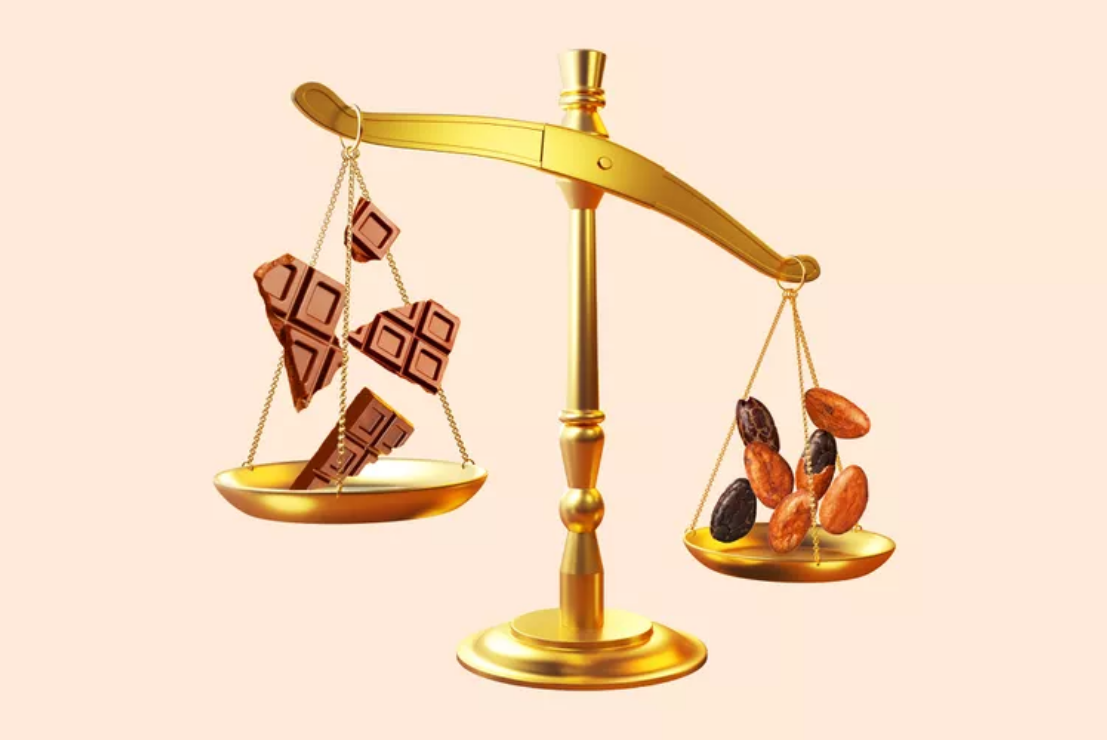Did you know that cacao is a delicate crop? The fruit produced by the cacao tree contains the seeds from which chocolate is made. Damaging and unpredictable weather conditions such as flooding and drought can negatively impact (and sometimes destroy) the entire yield of a harvest. Cultivating a crop of trees that takes about five years to reach peak production, and then produces a similar yield for about 10 more years before needing to be replaced, presents a challenge all its own. And that’s assuming an ideal climate—no floods, no drought.
Because cacao is a hand crop that relies on minimal pieces of agricultural machinery for cultivation, many concerns have ben raised around the cacao industry over the years, from farming practices to issues relating to poverty, workers’ rights, gender inequality, child labor and climate change.
What is ethical chocolate?
While there is no official definition, ethical chocolate refers to how the ingredients for chocolate are sourced and produced. “Chocolate has a complex supply chain, and cacao can only grow near the equator,” says Brian Chau, a food scientist, food systems analyst and founder of Chau Time.
How do I know if the chocolate I buy is ethical?
You may not be able to differentiate between chocolate made with or without ethically produced cacao beans. “The basic composition of raw materials will be the same,” says Michael Laiskonis, a chef at the Institute of Culinary Education and operator of ICE’s Chocolate Lab in New York City.
Fairtrade Certified
The Fairtrade certification stamp suggests that the lives of producers and their surrounding communities are improved by being a part of the Fairtrade system. By participating in the Fairtrade system, farmers receive higher shares of revenue based on the minimum price model, which sets the lowest level for which a cacao crop may be sold, and have more bargaining power during trade negotiations.
Rainforest Alliance seal of approval
Chocolate products that bear the Rainforest Alliance seal of approval (including an illustration of a frog) are certified to contain cacao that has been cultivated and brought to market with methods and practices that are considered by the organization to be both environmentally sustainable and humane.
USDA Organic label
Chocolate products that bear the USDA Organic seal ensure that the chocolate products have gone through the organic certification process, where cocoa farmers need to follow strict production, handling and labeling standards.
Certified Vegan
Cacao beans, by default, are a vegan product, so what does it mean when chocolate companies state on their packaging that they are a vegan product?
Potential drawbacks of certifications, seals and labels
While third-party certifications benefit farmers and producers to a certain extent, they also occasionally draw criticism from some in the industry for not going far enough to support farmers. For instance, Laiskonis says that a great deal of cacao grown by smallholder growers is organic by default. However, the hefty-priced certification process may be out of reach for these growers, preventing them from being one step closer to fair pay.
Are there nutritional differences between ethical and conventional chocolate?
There are no differences between ethical and conventional chocolate from a nutrition standpoint. Cacao beans are naturally bitter, and chocolate producers may add sugar and milk to mask the bitterness of the beans. As a general rule of thumb, the higher the listed cocoa percentage, the lower the sugar content. Generally, milk chocolates are higher in sugar and less bitter-tasting than dark chocolates, which contain less sugar and taste more bitter.
Chocolate made with plant-based milk alternatives, such as coconut, oat and nut additives, have become increasingly popular. These ingredients may offer sweeter and creamier textures than traditional dairy-based chocolates. Laiskonis advises, “Pay attention to the ingredient statement on chocolate packaging … dairy-free bars may be manufactured on shared equipment that also processes those containing milk products.”
Where can I buy ethical chocolate?
Due to the growing demand for ethical chocolate, you can now find them in your local grocery stores in addition to artisan markets and online. Food Empowerment Project has also come up with a list of dairy-free, vegan chocolate brands.
Bottom line: Should I buy ethical chocolate?
While your decision to purchase ethical or conventional chocolate is a personal choice, knowing where your favorite chocolate (and food in general) comes from makes you appreciate the farmers, the food system and the environment more, as well as reflect on the underlying socioeconomic issues.
Post time: Jan-17-2024






